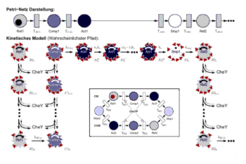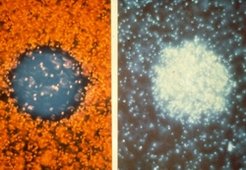Systems Biology
Systems biology seeks to integrate experimental and modelling approaches to study biological processes at different levels of complexity. An important aspect is the predictive power of these studies which allow to trigger further experimentation. The department has identified several research areas where the application of systems biology techniques seems very promising:
- the phototactic response of Halobacterium
- modelling of bioenergetics
- modelling of metabolic networks
- transcription regulation networks
In these areas, experimental data are available and techniques allowing further experimentation are established in the department.
Phototaxis in Halobacterium: A testcase for systems biology

Modelling of the phototactic response is a use case for systems biology. A simple physical event (a photon of light) triggers a cascade of responses of increasing complexity that result in an observable physiological response (response of the Halobacterium motility system). Compurational modelling of the response allows to reproduce all experimental results obtained by several groups over decades of research.
Phototaxis and Chemotaxis of Halobacterium

The chemotactic and phototactic response of Halobacterium exemplifies a highly integrated network of interactions at different levels of complexity. The phototactic response has been successfully modelled. Currently, the model is extended to include additional modules.
Bioenergetics of Halobacterium
The bioenergetics of Halobacterium is highly variable and interlinked. Halobacterium can use aerobic and anaerobic respiration, fermentation, and photosynthesis. Under conditions of ample energy supply, it can use the excess of energy to generate an ion gradient that can be used as source of energy under limiting growth conditions.

